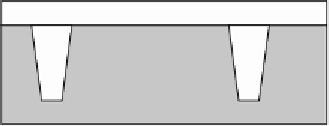Geoscience Reference
In-Depth Information
of pore pressures resulting in changes in the pore pressure gradient, and for large
interspaces between the vertical drains, i.e.
R > h
, the assumption of uniform
strains does not hold. In practice, for designing vertical drainage systems, one uses
simple diagrams, which are based on formula (13.3).
r
ln
?
2
h
u
?
2r
0
10
2R
(a) process around one drain (b) approximation
Figure 13.6 Consolidation by vertical drains
Vacuum drainage
Newer methods have been developed making use of vacuum drainage. The
method was actually first developed in China. The vacuum can be applied to a sand
fill, which is covered by impervious membranes, thereby drawing the pore water
up to the surface. Vertical drains enhance the action. Sometimes the lateral
boundaries of the area are sealed off by e.g. slurry walls to prevent drawing in
water from the vicinity.
One of such methods (Beaudrain) applies the vacuum directly to vertical drains,
and another method (IFCO) uses a hydro-mill trench cutter to bury horizontal
drains at the bottom of the trench, which is back-filled with sand (Fig 13.7).
Vacuum is then applied to the drains, which connect to the surface. The trenches
are about 0.25 m wide, up to 5 m deep and are repeated at e.g. every 3 m. Here,
vacuum pressure in the vertical drains or trenches is applied to enhance the
settlement process. The vacuum pressure, maintained by isolating the underground
from the atmosphere with a (local) impervious sealing at the surface or just above
the drains, works similar as a preloading.
IFCO method Beaudrain method
Figure 13.7 Vacuum consolidation
These methods have in common that the amount of applied vacuum increases
the hydraulic gradient, which determines the rate of flow of pore water from the
soil. When sufficient consolidation has been achieved, the vacuum pumps are
turned off, and slight swelling of the soil may occur as water is drawn back into the
soil. During swelling, the reload stiffness applies, and as it is higher than the virgin
































































Search WWH ::

Custom Search